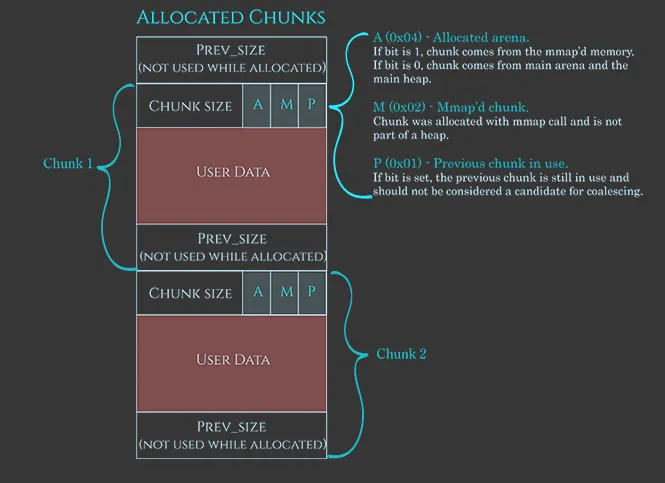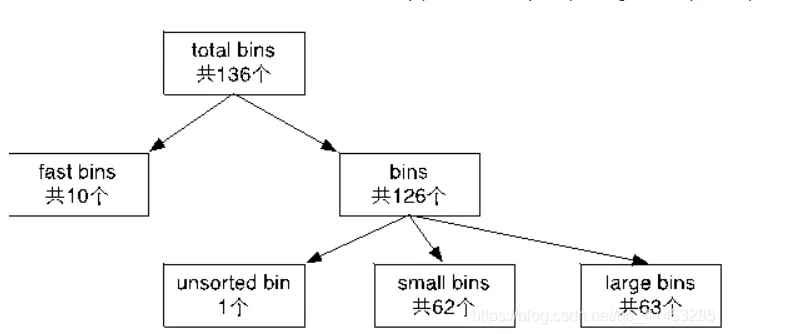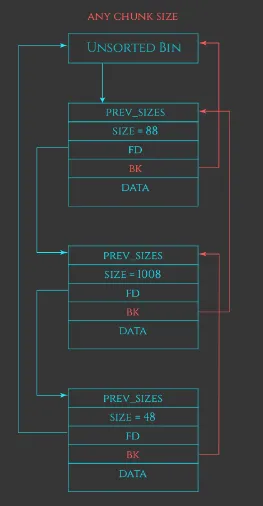目录
本文以初学者的角色对glibc的malloc进行简单的解析,从而了解malloc的简要知识,根据此文章,可以知道什么是fastbin,smallbin,largebin等等。
一、malloc时的内存布局
我们需要知道的是,通过glibc的malloc申请的内存,其返回的指针地址只是整个内存的chunk的userdata,其整体布局应该如下:
 根据上图,我们可以知道如下信息:
根据上图,我们可以知道如下信息:
- userdata是malloc返回的指针
- malloc申请的内存,包含多个chunk
- 多个chunk上下相连
- 每个chunk都包含一个prev_size
- prev_size本身存放了上一个未使用的chunk大小
- prev_size的下一个字节存放的是本chunk的size和AMP标志
- 其中A标志代表此内存是否来自main arena/main heap
- 其中M标志代表此内存是否来自mmap syscall
- 其中P标志代表此内存的prev chunk是否正在使用,如果正在使用,则prev_size的值无效 根据此,我们知道了malloc时的内存布局情况,下面看看free时,指针的布局情况
二、free时的内存布局
我们需要知道的是,通过glibc的free释放的内存,它不会直接返还给操作系统从而让其他程序使用,而是简单的标记这块地址为reused,只有程序的内存到达一定的阈值情况下,或者程序申请内存时当前chunk不足以满足的情况下,触发glibc的consolidate。如下是free时的指针布局情况,如下:
 根据上图,结合
根据上图,结合https://sourceware.org/glibc/wiki/MallocInternals,我们可以知道如下信息:
- M标志位和free chunk无关,因为mmap的内存通过munmap来实现,不是通过free
- free chunk维护了一个fwd/bck指针,这里fwd是forward,bck是backup,用于构造双向循环链表或单链表
- 如果P标志未置位,则代表free chunk的上一个chunk是unused的,也就是free的,那么可以向上合并这两个chunk
- 同理,如果下一个chunk是free chunk,那么也会被下一个chunk合并
- 我们知道所有的chunk来自于top chunk,所以如何free chunk和top chunk相邻,则合并到top chunk
- 如果tcache有空闲就,那么会将此free chunk放在tcache中
- 判断此free chunk大小,放入对应的bin中,例如(fastbin,smallbin,largebin) 根据此,我们可以知道系统中的malloc和free的基本行为如下:
- malloc分配了一个地址给应用使用,实际还包含了一个chunk struct
- free并没有释放内存给系统,而是等到consolidate时尝试合并和释放
三、各类bin的情况
根据上面的信息,我们提到了各类的bin,当我们在malloc和free时,其实对应的是每个chunk,而每个chunk都根据chunk_size代表一个bin类型。注意,这里的chunk_size是包含chunk结构体的size大小,而不是给用户的内存地址和偏移下的大小。
对于常规bin,例如smallbin,largebin等一共是126个,如下:
 对于fastbin,一个10个,所以总共有136个bin,如下:
对于fastbin,一个10个,所以总共有136个bin,如下:
 这里我们谈论的bin的个数其实是bin的数组,实际上不同的bin数组内部是用不同的链表实现。例如fastbin使用单链表,其他bin使用双向循环链表
这里我们谈论的bin的个数其实是bin的数组,实际上不同的bin数组内部是用不同的链表实现。例如fastbin使用单链表,其他bin使用双向循环链表
因为fastbin是单链表,所以结构体中的bck指针是没用的,只用到了fwd指针,如下:
 对于其他的bin,它使用了双向循环链表,如下:
对于其他的bin,它使用了双向循环链表,如下:
 这里比较清晰的是,在free chunk中,fwd和bck指针都用到了。
这里比较清晰的是,在free chunk中,fwd和bck指针都用到了。
除了各种bin的链表管理方式不同之外,我们还需要知道区分其bin的方式,通过内存大小,如下:
32 <= fastbin_size <= 128 128 < smallbin_size <= 1024 1024 < largebin_size <= 128*1024
注意,根据上面提到的,这个chunk size是包括chunk struct的size,而不是用户malloc的size。
至此,我们可以知道,通过malloc和free管理的内存,分为多个bin,有fastbin,smallbin,largebin等等。下面通过代码的方式来验证一下
四、测试程序
我们想要写一个测试程序,用来验证我们上述情况,首先,我们需要拿到chunk struct,这里以glibc 2.31为例,其结构体如下
struct malloc_chunk { size_t mchunk_prev_size; /* Size of previous chunk (if free). */ size_t mchunk_size; /* Size in bytes, including overhead. */ struct malloc_chunk* fd; /* double links -- used only if free. */ struct malloc_chunk* bk; /* Only used for large blocks: pointer to next larger size. */ struct malloc_chunk* fd_nextsize; /* double links -- used only if free. */ struct malloc_chunk* bk_nextsize; };
根据上面我们可以看到,在64位系统上malloc_chunk的大小是48(6*8)
为了解析chunk,我编写了inpect_chunk函数,如下
static void inspect_chunk(void *ptr) { struct malloc_chunk *chunk = (struct malloc_chunk *)((char *)ptr - 2*sizeof(size_t)); size_t chunk_size = chunk->mchunk_size & ~0x7; // Mask out the metadata bits int prev_inuse = chunk->mchunk_size & 1; int is_mmapped = chunk->mchunk_size & 2; int main_arena = chunk->mchunk_size & 4; printf("Chunk address=%p. ", (void *)chunk); printf("size=%zu. AMP=%#lx: \n\t", chunk_size, chunk->mchunk_size & 0x7); printf("main-arena=%s. ", main_arena ? "[No]" : "[Yes]"); printf("with_mmap=%s. ", is_mmapped ? "[Yes]" : "[No]"); printf("prev_in_use=%s. ", prev_inuse ? "[Yes]" : "[No]"); if (chunk_size <= 128) { printf("is fast bin.\n"); } else if (chunk_size <= 1024) { printf("is small bin.\n"); } else { printf("is large bin.\n"); } }
我对用户malloc的指针向前推进了16字节,此时我们得到一个chunk指针,它的类型是malloc_chunk。然后我用chunk来进行判断
为了进行一系列的bin测试,我编写了测试函数如下:
void main() { malloc_stats(); int* a = malloc(sizeof(int)); inspect_chunk(a); free(a); a = malloc(0); inspect_chunk(a); free(a); a = malloc(128-8); inspect_chunk(a); free(a); a = malloc(128-7); inspect_chunk(a); free(a); a = malloc(1024-8); inspect_chunk(a); free(a); a = malloc(1024-7); inspect_chunk(a); free(a); a = malloc(128*1024-23); inspect_chunk(a); free(a); printf("%ld <= fastbin_size <= %ld\n", MIN_CHUNK_SIZE, DEFAULT_MXFAST); printf("%ld < smallbin_size <= %ld\n", DEFAULT_MXFAST, MIN_LARGE_SIZE); printf("%ld < largebin_size <= 128*1024 \n", MIN_LARGE_SIZE); malloc_stats(); }
我分别malloc了0,128,1024,128*1024等相关字节
为了让这个代码正常运行,需要包含malloc.h头文件和必要的宏定义,宏定义需要从glibc源码中摘抄如下:
#include <stdio.h> #include <malloc.h> #include <string.h> #include <stdlib.h> #include <stddef.h> # define INTERNAL_SIZE_T size_t #define SIZE_SZ (sizeof (INTERNAL_SIZE_T)) #define MALLOC_ALIGNMENT (2 * SIZE_SZ < __alignof__ (long double) \ ? __alignof__ (long double) : 2 * SIZE_SZ) #define NSMALLBINS 64 #define SMALLBIN_WIDTH MALLOC_ALIGNMENT #define SMALLBIN_CORRECTION (MALLOC_ALIGNMENT > 2 * SIZE_SZ) #define MIN_LARGE_SIZE ((NSMALLBINS - SMALLBIN_CORRECTION) * SMALLBIN_WIDTH) #define MIN_CHUNK_SIZE (offsetof(struct malloc_chunk, fd_nextsize)) #define DEFAULT_MXFAST (64 * SIZE_SZ / 4)
至此,我们可以轻松的运行这个程序,如下:
gcc test_malloc_chunk.c -o test_malloc_chunk && ./test_malloc_chunk
从而得到输出如下:
Arena 0: system bytes = 135168 in use bytes = 3680 Total (incl. mmap): system bytes = 135168 in use bytes = 3680 max mmap regions = 0 max mmap bytes = 0 --------------------------------------------- Chunk address=0x559f9f0270. size=32. AMP=0x1: main-arena=[Yes]. with_mmap=[No]. prev_in_use=[Yes]. is fast bin. Chunk address=0x559f9f0270. size=32. AMP=0x1: main-arena=[Yes]. with_mmap=[No]. prev_in_use=[Yes]. is fast bin. Chunk address=0x559f9f0290. size=128. AMP=0x1: main-arena=[Yes]. with_mmap=[No]. prev_in_use=[Yes]. is fast bin. Chunk address=0x559f9f0310. size=144. AMP=0x1: main-arena=[Yes]. with_mmap=[No]. prev_in_use=[Yes]. is small bin. Chunk address=0x559f9f03a0. size=1024. AMP=0x1: main-arena=[Yes]. with_mmap=[No]. prev_in_use=[Yes]. is small bin. Chunk address=0x559f9f07a0. size=1040. AMP=0x1: main-arena=[Yes]. with_mmap=[No]. prev_in_use=[Yes]. is large bin. Chunk address=0x7f96c52000. size=135168. AMP=0x2: main-arena=[Yes]. with_mmap=[Yes]. prev_in_use=[No]. is large bin. 32 <= fastbin_size <= 128 128 < smallbin_size <= 1024 1024 < largebin_size <= 128*1024 --------------------------------------------- Arena 0: system bytes = 135168 in use bytes = 7088 Total (incl. mmap): system bytes = 135168 in use bytes = 7088 max mmap regions = 1 max mmap bytes = 135168
注意,这里我使用了glibc的malloc信息函数malloc_stats,它能够打印当前的malloc信息,我解析如下:
Arena 0: //Arena ID. There is only one thread. system bytes = 135168 //Dynamic memory obtained by the thread from the OS. in use bytes = 7088 //Dynamic memory used by the thread. Total (incl. mmap): //Total usage of the dynamic memory, that is, the accumulated dynamic memory used by each thread. system bytes = 135168 //Dynamic memory obtained by the process from the OS. in use bytes = 7088 //Dynamic memory used by the process. max mmap regions = 1 //Maximum number of mmap regions max mmap bytes = 135168 //Size of the memory corresponding to mmap regions
这里值得注意的是
1. 为什么in use bytes差8字节,这8字节在哪里?
这里7088 - 3680 = 2408,但实际上 1024+1040+144+128+32+32=2400。多了一个8字节
这是因为最开始的chunk,我们需要一个空的prev_size,这个prev_size的类型是size_t,也就是8。
2. 为什么是135168,系统字节是135168,mmap字节是135168
这里我们知道一个常识是,当内存超过128k时,系统通过mmap系统调用来分配内存,这时候是128*1024=131072
但是管理mmap这么多内存需要一个结构体,这样同时知道分配内存的最小单位是4k,那么4k为4*1024=4096
那么131072+4096=135168。
另一方面,我们在使用glibc程序时,默认程序启动时,glibc的内存管理提供你128k内存供你使用,这里还需要附带1个4k页。然后程序的malloc行为实际上是通过top chunk来进行分配即可。
所以一个程序运行时,默认glibc管理程序会给这个程序提供135168字节的system bytes